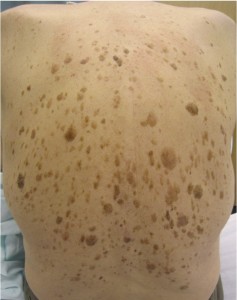Seborrheic Keratosis (SK)
What is this brown stuck on growth?
Seborrheic keratoses (SK’s, or wisdom spots) are extremely common.
 They can look like warts, moles, actinic keratoses, and skin cancer. They differ, though, from these other skin growths.
They can look like warts, moles, actinic keratoses, and skin cancer. They differ, though, from these other skin growths.
Seborrheic keratoses have a waxy, “stuck-on-the-skin” look. Many patients wonder what these benign growths are.
Patients often wonder how to get rid of these growths because they are unsightly, worried about cancer, itch, or bleed. In most people, seborrheic keratoses first appear in middle age or later.
People who are most likely to get these growths have family members with seborrheic keratoses. Children rarely have these growths.
It is not uncommon that a patient has many seborrheic keratoses on their back and would like them treated because they don’t like the appearance or they itch or become inflamed by clothing or shaving.
A female in her 70’s presented with approximately eighty SK’s on her back.
She requested an evaluation by a provider at Advanced Dermatology. A few seborrheic keratoses around the waist and bra lines were red, itchy, and inflamed.
The patient explained that these growths have impacted her life in a negative way.
The itch has affected her sleep and occasionally noticed bloodstains on her clothing. After a discussion with the patient, treatment was performed during her office visit of the irritated SK’s with cryotherapy using liquid nitrogen.
This procedure took approximately 30 seconds.
It was explained to the patient to expect a reddish-pink sore spot for a few days after, a small blister may form underneath the growth and the spot may slough off on its own.
On the patient’s follow up, she was extremely grateful for having these treated.
She reported it took about five days for the sore spot to resolve and for the lesion to slough off. Now that the SK’s are gone she does not itch or become irritated anymore.
Most of the time, a dermatology provider can tell if your skin growth is a seborrheic keratosis by looking at it. Sometimes a seborrheic keratosis can look like skin cancer.
If it does, the provider will remove the growth so that it can be looked at under a microscope. This is the only way to tell for sure whether a growth is or is not skin cancer.
Treatment of Seborrheic Keratoses (SK)
Because seborrheic keratoses are harmless, they most often do not need treatment. Seborrheic keratosis may be removed when it is:
- Hard to distinguish from skin cancer.
- Large or gets easily irritated when clothes or jewelry rub against it.
- Unsightly to a patient.
The most common treatment for seborrheic keratoses is cryosurgery.
Cryosurgery is where liquid nitrogen (a very cold liquid) is applied to the growth using a spray gun.
This freezes the growth.
The seborrheic keratosis tends to fall off within days. Sometimes a blister forms under the seborrheic keratosis and dries into a scab-like crust. The crust will fall off.
After the removal of a seborrheic keratosis, the skin may be lighter than the surrounding skin. This usually fades with time. Sometimes it is permanent.
Most removed seborrheic keratoses do not return. But a new one may occur elsewhere.
Don’t ever think your skin condition is too minute. Here at Advanced Dermatology, we think it is very important to have a proper evaluation. We care about your skin as much as you do.


